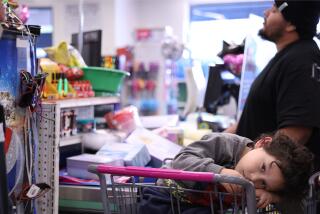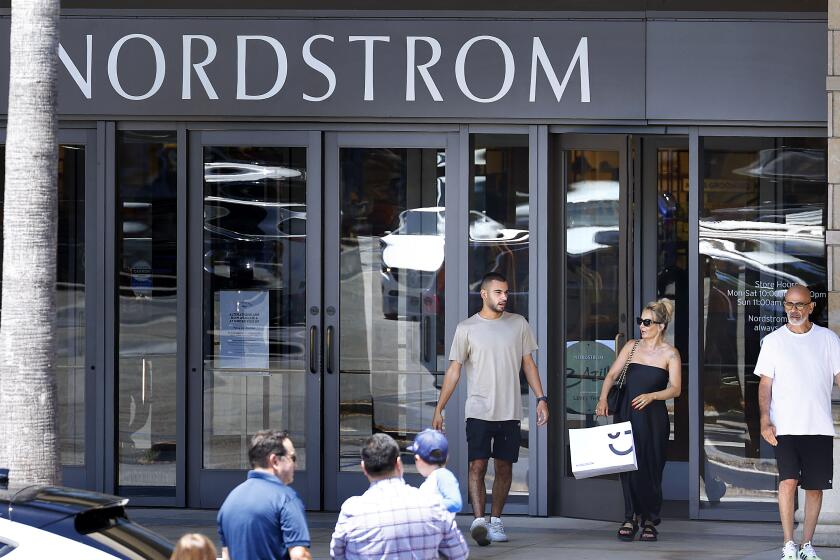America Changes Diapers: From Cloth to Disposable
- Share via
The letter announcing the demise of Tidy Didy Diaper Service devastated Shawn Shannon, a 43-year-old Laguna Niguel working mother whose son Jake still is months away from potty training.
“I started crying when I heard the news,” said Shannon, who works as a jewelry expert at Nordstrom. “It was like getting kicked in the stomach.”
Delivering sweet-smelling, freshly washed diapers to Shannon and generations of mothers like her had made Brea-based Tidy Didy a Southern California institution for more than 60 years.
But in late January, Tidy Didy and its sister service, Babyland in National City south of San Diego, made their final runs, victims of slackening demand and mounting losses.
Tidy Didy’s fall is only the latest. Cloth diaper services are disappearing nationwide--so swiftly that they are on the brink of extinction.
New York City, once home to 23 companies, today has only three or four. Los Angeles has but a single service. The Bay Area’s venerable Dy-Dee Wash folded in October. Now, much of Orange County and most of San Diego, Riverside and San Bernardino counties are without diaper deliveries.
Diaper services “will be nonexistent within two years, and I’d be surprised if they last even that long,” said Jim Nowakowski, chief executive of L&N; Uniform Supply Co., which owned Tidy Didy and Babyland.
Business was good at both services less than a decade ago, when cloth diapers were seen as environmentally correct. Mothers by the thousands abandoned disposables, a soiled symbol of America’s throwaway culture.
But cloth mania proved short-lived.
Slick advertising campaigns by Procter & Gamble, the maker of Pampers and Luvs, and Kimberly-Clark, the maker of Huggies, planted doubt in the public’s mind about the benefits of cloth diapers. Environmental fervor cooled. Overworked parents put aside misgivings and embraced the convenience of disposables as never before.
Future Holds No Respite
Eventually, cloth diapers’ share of the domestic market fell below 5%, said John A. Shiffert, executive director of the National Assn. of Diaper Services, a trade group that has seen its membership tumble. In 1992, the group had 200 members. Its membership today: just 30.
The future offers no respite for the few remaining diaper services. The national birthrate has been declining over the past decade, according to the U.S. Census Bureau. That means fewer infants in diapers.
Still, some refuse to give up, despite the long odds.
“I’m hopeful that there will always be a niche for diaper services, but I could be wrong,” said Judy Aagard, co-owner of Tiny Tots Diaper Service Inc. in Campbell, Calif. Indeed, her company now has 3,000 customers, down from a peak of 15,000 in 1990.
Tidy Didy--first called Dainty Didy and later Dy-Dee Diaper--was among the first diaper services in California. It was founded in Pasadena by Jim O’Neil in 1938. An Orange County branch opened in 1955 to serve the swelling ranks of mothers from Santa Ana to San Clemente.
For Tidy Didy and other diaper services, the years between 1950 and 1965 represented something of a golden age. Birthrates were up. The disposable diaper had yet to make inroads. Diaper services proliferated. As late as the mid-1960s, cloth diapers accounted for more than 95% of the domestic market.
The first paper diapers were bulky and difficult to change. But manufacturers quickly improved them, and Pampers and other disposable brands, generally more absorbent and less messy than cloth, surged in popularity. Diaper services went out of business as an industrywide consolidation got underway. Cloth’s market share eroded throughout the 1970s and ‘80s, dipping below 20% in 1987, said Shiffert of the diaper services association.
But Tidy Didy, a beneficiary of Southern California’s growing environmental awareness, continued to prosper. The company snapped up Angel Diaper Service, a Long Beach competitor, in the mid-1970s. Later, the business was divided, with Tim O’Neil, the founder’s son, running the Orange County company and his brother Brian overseeing Dy-Dee Diaper Service Inc. in Pasadena.
The industry got an unexpected boost in the late 1980s. Environmentalists and the media publicized stories of a garbage barge carrying 3,100 tons of trash that sailed up and down the East Coast for months in search of a home. Solid-waste concerns prompted calls to ban disposable diapers. That jump-started a return to cloth diapering, which received another push with the 20th anniversary of Earth Day in 1990.
To meet the demand, Tidy Didy and other diaper services expanded their operations. In 1991, the company moved to Brea and into a 50,000-square-foot building, more than eight times the size of its old Orange headquarters. Tidy Didy’s customer base surged to 12,000, a threefold increase over a decade earlier.
Ironically, the forces that would rip diaper services to shreds emerged simultaneously: In 1990, the Natural Resources Defense Council took a neutral position in the diaper debate. The environmental group found that although disposables accounted for about 2% of the material in landfills, cloth diapers had environmental consequences of their own. The cotton used to produce them, for instance, is grown with lots of water and pesticides.
Add to that the air pollution created by diaper delivery trucks and “the environmental community couldn’t and cannot make a clear recommendation about which one is better,” said Natural Resources senior scientist Allen Hershkowitz,
The much-maligned disposable suddenly took on a less sinister air.
More damaging, P&G; and Kimberly-Clark launched a sustained advertising campaign that suggested disposable diapers were just as “green” as cloth ones. One commercial showed a pile of compost covering tree roots. The voice-over: “Ninety days ago, this was a disposable diaper.” Although P&G; later withdrew the ad, which critics characterized as misleading, the harm had been done.
Undersized and Out-Marketed
Diaper services, mostly mom-and-pop operations, could do little to counteract the marketing blitz.
“The cost of one prime-time disposable ad by Procter & Gamble is probably equal to the entire advertising budgets of all the cloth diaper businesses for the entire year,” said John O’Kane of ABC Diaper Service Inc. in Berkeley. “Every day, they’re beating us to death with their ads. How do you compete against that?”
L&N; thought it could. In 1992, the Santa Ana company paid about $2 million for Tidy Didy, two years after snapping up Babyland. L&N;’s expectations were high.
Tidy Didy immediately began advertising in local newspapers and on cable-TV stations. New mothers were inundated with brochures extolling the benefits of cloth. Tidy Didy officials forged close links with child-birth educators to spread the word, said L&N;’s Nowakowski.
Those efforts initially paid off. Both Tidy Didy and Babyland remained successful until 1994, far longer than most other diaper services. But as prices of disposables dropped at such big-box stores as Kmart and Costco, so did Tidy Didy’s fortunes.
“The disposable kept getting cheaper, more absorbent and more comfortable,” Nowakowski said. “They’re still getting better.”
Families spend, on average, $515 per year to swaddle their infants in disposable diapers, according to P&G.; By contrast, diaper services run from $624 to $780 annually, said Theresa Rodriguez Farrisi, author of “Diaper Changes: The Complete Diapering Guide and Resource Book.”
To win back disaffected mothers, Babyland began selling disposables, which it later picked up for recycling. Nowakowski said the program was shelved after a year for lack of interest. In 1997, Tidy Didy expanded its business by offering customers weekly deliveries of laundered 100%-cotton bibs, blankets, crib sheets and pajamas. That, too, failed to generate new business.
“We had been doing everything that we thought possible,” Nowakowski said. “But we saw the writing on the wall.”
L&N; began to wind down operations at both Tidy Didy and Babyland. In Brea, the company diversified into the linen and medical apparel cleaning businesses, banishing Tidy Didy to a tiny corner of the plant. In National City, Babyland laid off workers.
Annual sales at Tidy Didy dropped to $550,000 last year from a high of $2.8 million. Babyland’s revenues sank to $250,000 from a high of $1.2 million. Both operations closed their doors Jan. 21. Most of Tidy Didy’s 29 employees were transferred to other L&N; operations, said Dave Robbins, the company’s former vice president.
The loss of the last Orange County-based diaper service has been difficult for some residents. Although Dy-Dee Diaper in Pasadena makes deliveries to North County, families south of Irvine are completely out of luck.
“We’re not faring very well,” said former Tidy Didy client Cedric Green, a 31-year-old Lake Forest resident with three kids. “We have to constantly wash diapers. At this point, we’d take any diaper service.”
(BEGIN TEXT OF INFOBOX / INFOGRAPHIC)
The Tidy Didy Trail
1938: Jim O’Neil founds Dainty Didy Service, which later becomes Dy-Dee Diaper Service, in Pasadena
1950-1965: “Golden Age” for services deliverying cloth diapers. New York City has 23 services. Philadelphia has 15
1949: Saks Fifth Avenue begins selling disposable diaper, invented by housewife Marion Donovan.
1955: Jim O’Neil opens a branch of Dy-Dee Diaper in Orange
1961: Procter & Gamble introduces Pampers
1976: Jim O’Neil dies
1978: Kimberly-Clark introduces Huggies
1990: 20th anniversary of Earth Day fuels the sale of cloth diaper
1990: Natural Resources Defense Council takes a neutral position in the diaper debate, undercutting the environmental argument in favor of cloth
1990: Procter & Gamble launches ambitious advertising campaign questioning whether cloth diapers are better for the environment.
1991: Dy-Dee Diaper moves from Orange into a 50,000 square-foot facility in Brea
1992: L & N Uniform Supply Co. buys Dy-Dee Diaper from Tim O’Neil, Jim O’Neil’s son, for $2 million and renames it Tidy Didy Diaper Service.
1992: Tidy Didy has 12,000 customers and nearly $3 million in sales
1999: Tidy Didy customers shrink to 1,200 and sales dwindle to $550,000
January, 2000: Tidy Didy goes out of business, eliminating diaper service for South Orange County.
Source: Tidy Didy Diaper owners, Procter & Gamble, Natural Resources Council
More to Read
Inside the business of entertainment
The Wide Shot brings you news, analysis and insights on everything from streaming wars to production — and what it all means for the future.
You may occasionally receive promotional content from the Los Angeles Times.










